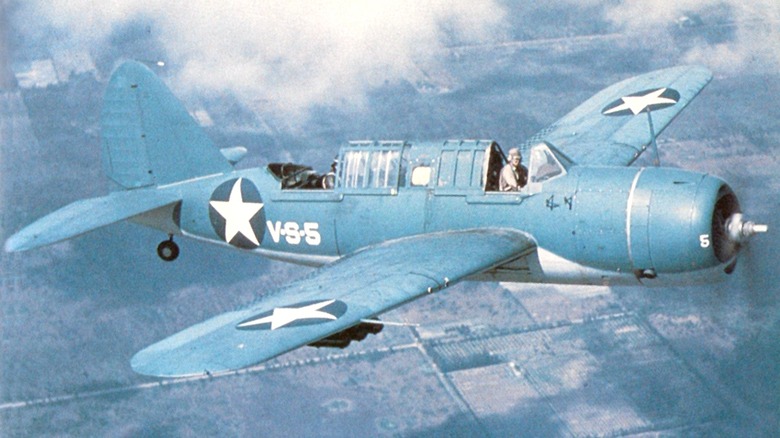World War 2's Worst Bomber Was Basically A Flying Coffin
"Notoriously difficult to fly" is tossed around the internet and among pilots as a way of quickly explaining how dangerous it is to fly certain aircraft. Nobody wants to climb into a plane's cockpit and know that it's a dice roll whether they'll climb out again. Still, while many aircraft have been dubbed "flying coffins," few have earned the distinction as easily as the Brewster SB2A Buccaneer, used by the United States and United Kingdom during World War II.
The Buccaneer was a single-engine scout bomber designed for the U.S. Navy, and produced between 1941 and 1944. The Brewster Aeronautical Corporation built over 770 of them during history's biggest and deadliest war, but none served in combat. That's not great for a combat aircraft built in the hundreds during World War II, but that's what happened, and it was due entirely to the fact that the Buccaneer was a horribly designed death trap that failed to serve the function for which it was designed.
The National Naval Aviation Museum in Pensacola, Florida, describes the Buccaneer quite succinctly: "Overweight, underpowered, and lacking maneuverability, the Brewster SB2A Buccaneer was a classic failure." The British took possession of many of the aircraft that were produced from the initial order of 750, but relegated them to function as target tugs, trainers, and ground maintenance trainers. Here's why the Brewster SB2A Buccaneer was so terribly designed and would be a worthy addition to our list of the worst military bombers ever made.
The Brewster SB2A Buccaneer
The SB2A Buccaneer was a small scout bomber powered by a single Pratt & Whitney R-2600-8A radial engine capable of producing 1,700 horsepower, enabling a maximum speed of 275 mph. It could climb to a ceiling of 25,400 feet and had a range of 1,095 miles when armed. It also had eight .30-caliber machine guns, so it was a reasonably good aircraft on paper. But when delivered to the U.S. Navy and U.S. Army Air Forces, it was deemed unsuitable for combat operations, and many didn't want to fly it at all. Foreign recipients of the Buccaneer made similar determinations, and it was barely flown throughout the war. Only two survive in museums today.
A lack of maneuverability was the Buccaneer's main problem, making it more a slow-moving target than an operational scout bomber. And the plane wasn't ruggedized, causing stress issues that made it unreliable. Toward the end of the war, as new Buccaneers were completed, some went right to scrapyards to be taken apart. As a result, it was a big reason the Brewster Aeronautical Corporation didn't survive long after the war ended, folding in 1946.
Typically, the term "flying coffin" is reserved for aircraft that cause multiple pilots' deaths due to poor design and manufacture, but the Buccaneer is different. It earned the distinction by being so unreliable and hard to operate that pilots didn't see it as a bomber — they saw it as a flying coffin.

